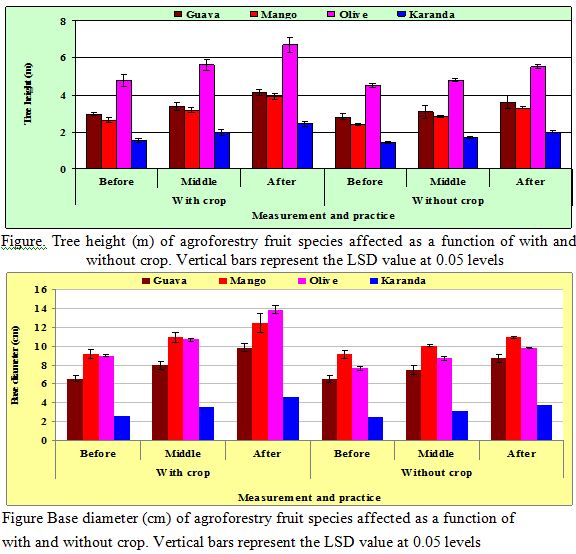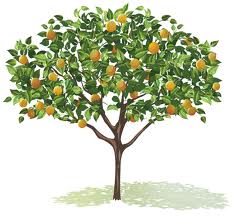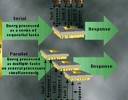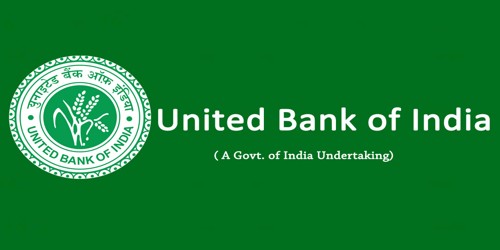Height growth
The height of the fruit tree species showed mean significant differences among the species at all dates sampled i.e. before, middle and after experiment for with and without crops .
The effect of crop cultivation on tree height was significant. At the time of before experiment, the height of P. guajava, M indica, O. europea and C. carandus were 2.94, 2.63, 4.79 and 1.53 m respectively for with crop and 2.93 2.40, 4.23 and 1.43 m respectively for without crop. Regardless of experiment, the tree height growth was much pronounced for with crop than that of without crop.
At the middle of the experiment, i.e. one year after crop cultivation, the significant differences in height growth were observed among the tree species. The mean value of height for P. guajava, M. indica, O. europea and C. carandus were 3.37, 3.17, 5.62 and 1.95 m respectively for with crop and 3.07, 2.83, 4.80 and 1.70 m respectively, for without crop. The value indicated that the mean tree height was the highest for with crop than without crop.
At the end of the experiment, i.e. after two years of crop cultivation, the height of the tree species for with crop was significantly superior to the tree without crop. The mean height of P. guajava, M. indica, O. europea and C. carandus were 4.12, 3.92, 6.72, and 2.45 m for with crop and 3.60, 3.30, 5.53 and 2.00 m for without crop. It is noted that the height was much pronouncedly highest for with crop than without crop. However, Okorio (1987) and Jama and Getahum (1991) reported that enhanced growth in tree height under agroforestry system was probably due to the indirect benefits of fertilization and weeding of the associated intercrops.
Diameter growth
Diameter growth measurements at 30 cm height are becoming increasingly common (Steward, 1991). The diameter growth of the four species is demonstrated in the figure 100. The diameter growth varied significantly among the tree species at all dates of measurement . Crop cultivation had a significant effect on different tree species (Appendix table 50). Base diameter of guava, mango, olive and karanda plant were recorded at before, middle and after the experimentation at the time of first weak of November 2008, November 2009 and November 2010 based on with crop and without crop.
Before experiment, base diameter of P. guajava M. indica, O. europea and C. carandus were 6.55, 9.18, 9.80 and 2.58 cm respectively with crop and 6.53, 9.13, 7.67 and 2.50cm respectively without crop. After one year of experiment, the mean diameter was 8.00, 11.00, 11.68 and 3.48 cm respectively for P. guajava, M indica, O. europea and C. carandus respectively with crop while that was 7.50, 10.03, 8.70 and 3.17 cm respectively without crops i.e. under tree control. After 2 years of experiment, the diameter growth was 9.83, 12.32, 13.84, and 4.66 cm for P. guajava M. indcka, O. europea and C. carandus respectively with crop while that was 9.07, 10.03, 8.70, and 3.17 cm respectively without crops.
Figure shows a wide variation in diameter growth after one and two years of experiment. Fastest growth was observed in O. europea and M. indica, P. guajava were intermediate while C. carandus showed the slowest growth. On the other hand the diameter growth of P. guajava, M. indiaca, O. europea and C. carandus was higher with crop than without crop. So, crop cultivation under tree significantly influence on diameter growth of tree species

Trunk height
The trunk height o four fruit trees showed significant differences among the spscies at all data sample i.e. before, middle and after the experiment and with and without tree (Fig. 106).
Before experiment, the trunk height of P guajava, M. indica, O. europea and C. carandus were 0.78, 0.91, 1.33 and 0.53 m respectively with crop and 0.67, 0.77, 0.87 and 0.53 m respectively without crop.
One year after experiment, the significant differences were observed as compared with crop without crop. At that time the trunk height of P. guajava. M. indica, O. europea and C. Carandus were 1.47, 1.43, 1.80, and 0.93 m respectively for with crop and 1.13, 1.10, 1.23 and 0.77 m respectively for without crop.
After two years of experiment, the trunk height of P. guajava M. indica. O. europea and C. carandus were 2.03, 1.91, 2.43 and 1.29 m respectively for with crop and 1.57, 1.43, 1.63, and 1.07 m respectively for without crop. This is clearly stated that crop cultivation under these fruit trees had positive effects because of management practices like irrigation, fertilizer application, root pruning, branch pruning etc had positive impact on tree trunk growth.
Canopy volume
Canopy volume varied significantly among the treatments due to cultivation of different crops understorey. Tree canopy volume increased gradually for both with crop and without crops at the time of before, middle and after experiment. Before experiment, the canopy volume of P. guajava, M indica, O. europea and C. carandus were 3.79, 2.67, 1.20 and0.60 m2 respectively for with crop and 2.94, 2.40 1.04 and 0.62 m2 without crops. After one year of experiment, i.e. at the middle of experimenta, P guajava, M indica, O. europea and C. carandus attained a mean canopy volume of 7.07, 4.57, 3.21 and 1.37 m2 for with crop and 4.79, 3.48, 2.26 and 1.03 m2 for without crop which was tree control. After the experiment, i.e. two years of crop cultivation a similar trend in canopy volume growth observed. So, the canopy volume of P. guajava, M. indica O. europea and C. carandus were 10.24, 6.75, 6.05 and 2.43 m2 for with crop and 6.57, 4.88, 3.80, and 1.56 m2 for without crop.
It is therefore clear that canopy volume was increasing gradually without crop and found more prominent with crop. As a result he canopy volume was in the rank of guava> mango> olive > karanda.

















